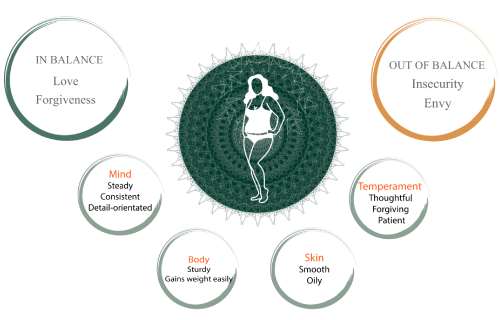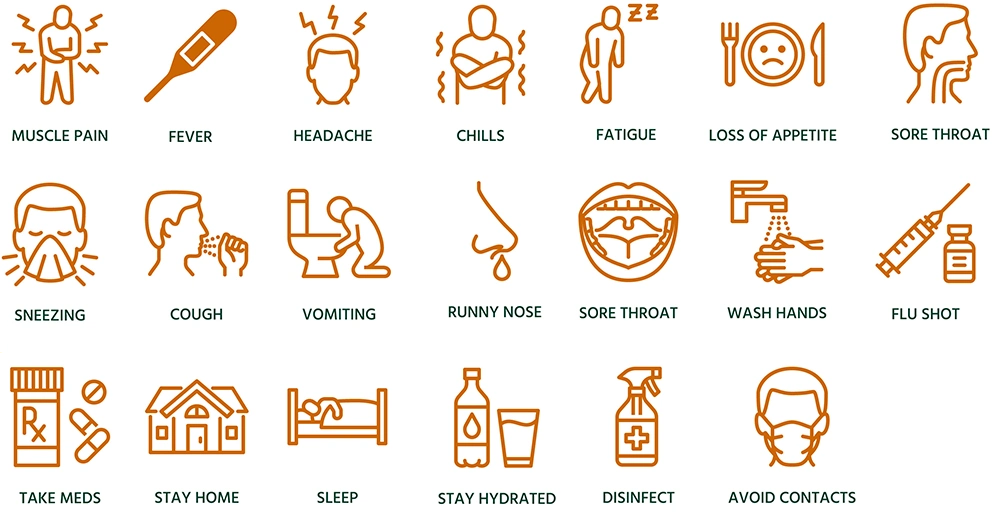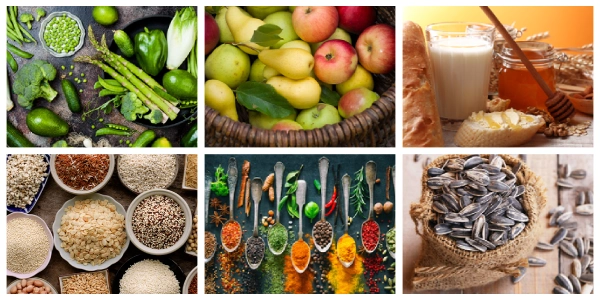The Kapha Dosha is a combination of Earth and Water elements out of 5 life elements Aakash (space), Jala (water), Prithvi (earth), Teja (fire), and Vayu (Air), which makes it calm, steady, heavy, slow, cool, and soft.
People with the Kapha Prakriti are detail-oriented and follow systems. They may appear slow and sluggish to others at times, but they have incredible endurance and strength.
When Kapha-dominant people create a new goal for themselves, they stick to it with patience and persistence until they achieve it.
The Spring season is associated with Kapha Dosha.
A person with a Kapha Prakriti or constitutional character is known for keeping things together and providing support to others. They are rarely agitated. This dosha is associated with assertiveness, strength, and love.
Furthermore, The Kapha Dosha has five types. Each Kapha type has different roles like:
1. Kledak: This Kapha helps break down the food we eat, and it protects the stomach lining from the acids that aid digestion. It manages saliva, mucus, and other stomach secretions.
2. Bodhak: The mouth and tongue are the primary positions for this Kapha. It moistens the food we eat, making it easier to digest and regulating the perception of taste.
3. Shleshak: This Kapha is known to lubricate the joints and aid them in functioning properly. It maintains stability as well as protects us from wear and tears in the long term.
4. Tarpak: It regulates the functioning of the cerebrospinal fluid. Tarpak Kapha is known to preserve the sensory organs and lubricates the nerves. It is found in the head region and is often comparable to the myelin sheath, ensuring normal nerve conduction.
5. Avalambak: It is primarily positioned in the chest area and is thought to work as a protective shield for the heart and respiratory system.
Common characteristics of Kapha Dosha
Kapha dosha is responsible for our body’s integrity, lubrication, sturdiness, and support. It promotes emotional stability, mental, physical endurance, and the ability to feel deeply, be compassionate, and patient.
Kapha is roughly translated as “that which holds things together.”
When the Kapha Prakriti or constitutional character within us is in balance, we feel a sense of support in body function.
Kapha’s thick, sturdy, and preserving characteristics maintain our body heat and protect our organs.

Here are some common characteristics of Kapha dominated person:
| Type/Features | Common Traits |
|---|---|
| Body Feature | Broad body, strong bones, and muscles, curvy physique. |
| Skin | Soft and cool skin. |
| Hair | More likely to have thick, wavy hair. |
| Weight | Easily gains weight, and tends to be overweight. |
| Strengths | Enjoy good stamina, healthy bones and joints, and a strong immune system, compassionate, caring, trustworthy, patient, wise, joyful. |
| Weaknesses | Slow metabolism, lethargy, oversleeping, respiratory problems, high risk of heart disease, mucus build-up, prone to depression. |
| Food Preference | Prefer spicy, bitter, and sweet flavors. |
| Speech | Have a deep voice and speaks slowly |
Sounds similar? Know your Dosha type by taking our comprehensive Dosha quiz today!
Signs of a Kapha Imbalance

Kaphas are calm, grounded, and sincere when they are in balance. When out of balance, they binge eat and avoid exercising, resulting in weight gain and diabetes.
They are more likely to suffer from sluggishness, obesity, bloating, flu, sinus congestion, and other mucus-related illnesses as Kapha is most dominant in the chest.
Here are some common ailments caused due to Kapha Imbalance:
- Common cold
- Congestion
- Chills
- Seasonal allergies
- Bronchitis
- Sinusitis
- Appetite loss
- Anorexia
- Weight gain
- Bloating
- Swelling and puffiness
- Lethargy, lack of motivation
- Pneumonia
- Cysts
- Depression
- PCOS/ PCOD
- Hypothyroidism
- Sluggishness
- Excessive sleep
- Weakness
- Indigestion
- Goiter
- Obesity
- Urticaria
- Pallor
Diet to Balance Kapha Dosha
Ayurveda advises a special diet and nutrition to balance the Kapha. Bitter, astringent, and pungent tastes are prescribed and the food prepared should be dry, light, and warm.
They require foods that will stimulate their minds while minimizing the overall food consumption as they are likely to put on weight.
In Ayurveda, all six tastes (sweet, sour, salty, pungent, bitter, and astringent) are advised for healthy digestion.

Here are some insights on the diet to balance Kapha Dosha :
| Category | Foods to Eat | Foods to Avoid |
|---|---|---|
| Vegetables | Green leafy vegetables, asparagus, artichoke, cabbage, cauliflower, broccoli, celery, peas, zucchini, okra, eggplant, cilantro, Daikon Radish, and Chili Peppers | Sweet potato, carrot, beets, tapioca |
| Fruits | Apple, pear, pomegranate, cranberry, peach, papaya, guava, grapes, and persimmon | Pineapples, bananas, avocados, oranges, peaches, coconuts, melons, dates, and figs |
| Spices | Ginger, black pepper, mustard seeds, mint, cinnamon, cloves, cayenne, garlic, turmeric, cardamom, coriander, caraway, fenugreek, nutmeg, and fennel | Salt |
| Grains | Barley, millet, corn, tapioca, muesli, amaranth, buckwheat, rye, Black beans, mung beans, and red lentils | Barley, millet, corn, tapioca, muesli, amaranth, buckwheat, rye, Black beans, mung beans, and red lentils |
| Nuts | Sunflower, pumpkin | Cashews, pistachios, and pine nuts |
| Oils | Olive oil, ghee, coconut oil, almond oil, corn oil, sunflower oil, and canola oil | Safflower oil, apricot oil, coconut oil, flaxseed oil |
| Others | White Chicken, eggs, turkey, low-fat milk, and low-fat yogurt and honey. | Red meat, lamb, pork, cheese, cream, tuna fish, sea fish, dark turkey, beef, sardines, seafood, and salmon, butter. |
Tips for balancing Kapha Dosha
People with Kapha Dosha tend to have a slower metabolism and low appetite for food, and they can benefit from fasting, occasionally.
Individuals with Kapha dosha should focus on regular exercise, a balanced diet, maintaining a warm body temperature, and developing a regular sleep schedule for good health.
Here are a few tips that will help you manage your Kapha Dosha better:

- Get a lot of exercises.
- Try Cardio workouts.
- Get up early in the morning.
- Avoid fatty and frozen foods.
- Try a liquid fast, once a week.
- Avoid taking naps during the day.
- Change up your routine from time to time.
- Exercise on a consistent and intense basis.
- Try essential oils like cinnamon and eucalyptus.
- Include meditation, journal keeping in your routine
- Dry brushing and massaging your body can help promote blood circulation.
- Surround yourself with colors like red, yellow, orange, and green.
- Avoid alcoholic beverages, caffeinated beverages, and chocolate.
- Eat lighter meals throughout the day; lunch should be your main meal.
- Oil massage (abhyanga) with light or stimulating oils like mustard or olive.
Every day, our lives, surroundings, and health change. It is essential to keep updated on changes and how they influence us.
We recommend you take our Ayurveda dosha quiz to learn more about restoring balance.





Do you want to learn more? Ask us! OR Do you know more about this topic? Educate us.